Management Accounting Report: Cost Analysis and Budgeting, Sept
VerifiedAdded on 2020/07/23
|20
|6081
|292
Report
AI Summary
This report on management accounting analyzes the costs incurred by Jeffrey & Son's Ltd. It begins with categorizing various types of costs and calculating unit costs using different costing methods, including job costing and absorption costing. The report then delves into cost analysis, focusing on exquisite costs and preparing a cost report for the month of September. Performance indicators are used to identify areas for improvement, and options to reduce costs and enhance value are suggested. The report also covers the purpose and nature of the budgeting process, selecting appropriate budgeting methods, preparing budgets, and creating a cash budget. Furthermore, the report includes variance analysis, possible causes of variances, and recommended actions. Finally, it presents an operating statement reconciling the budget and actual results and reports the findings to management, adhering to identified responsibility centers. The report concludes with an overview of the findings and recommendations.
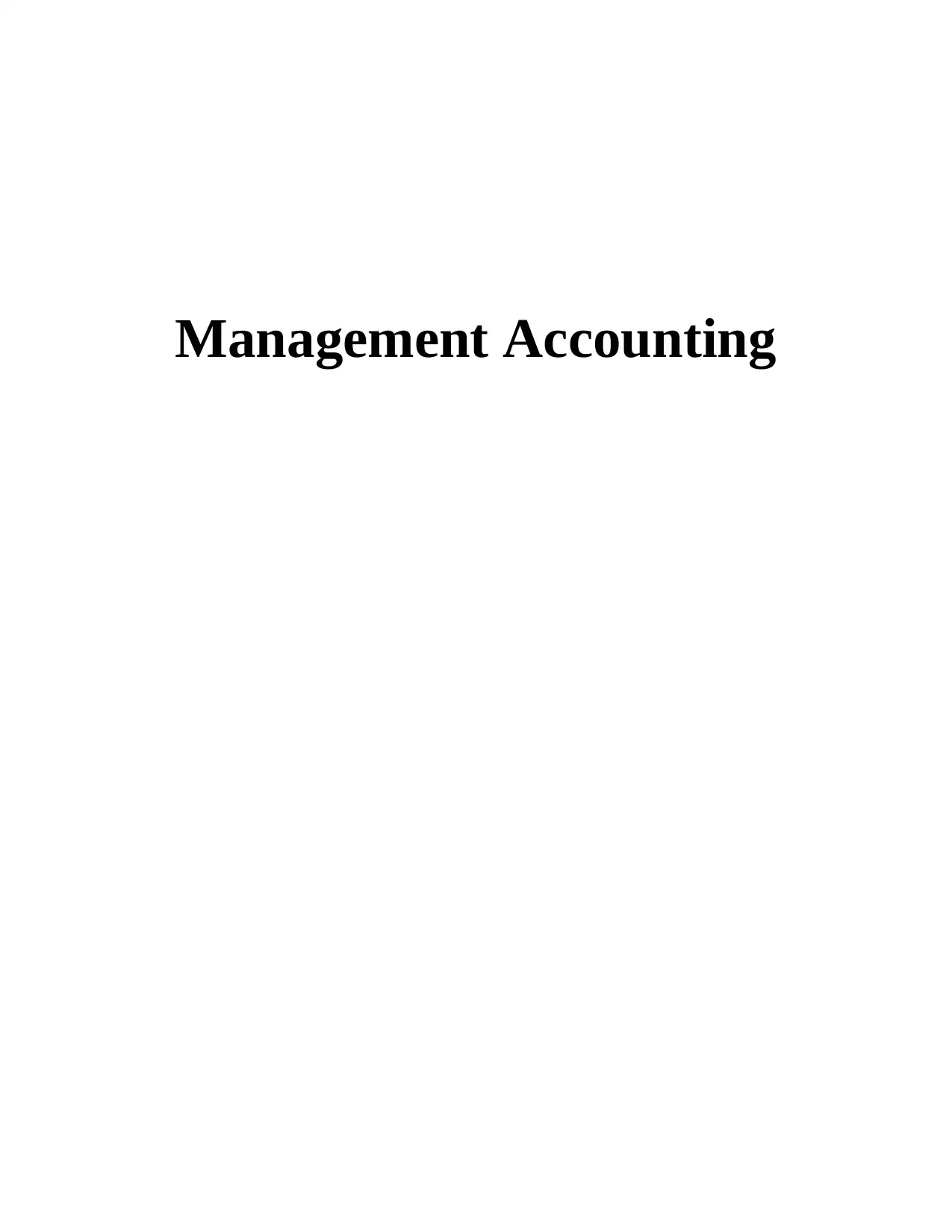
Management Accounting
B
7
9
?
9
6
4
C
M
a
i
!
#
B
7
9
?
9
6
4
C
M
a
i
!
#
B
7
9
?
9
6
4
C
M
a
i
!
#
B
7
9
?
9
6
4
C
M
a
i
!
#
Paraphrase This Document
Need a fresh take? Get an instant paraphrase of this document with our AI Paraphraser
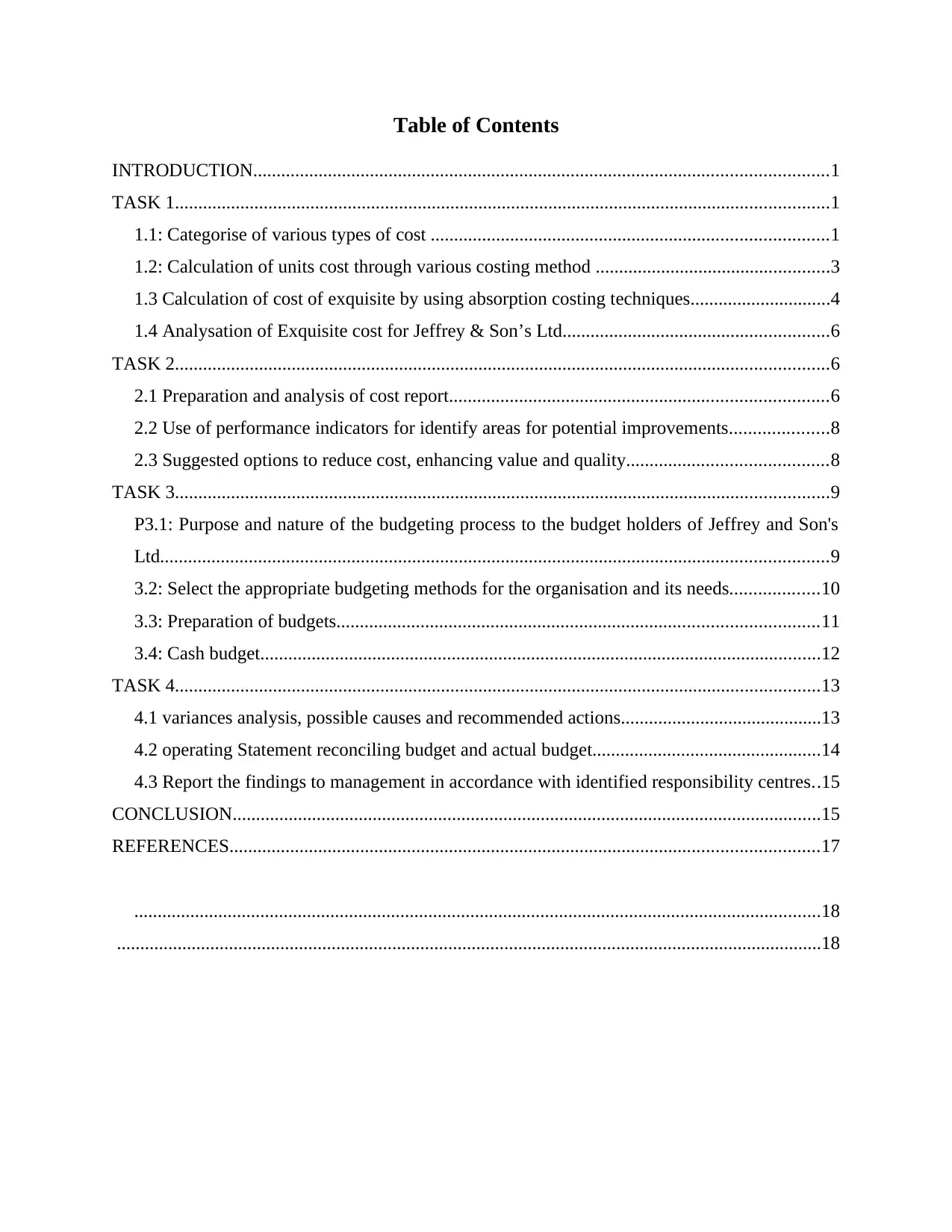
Table of Contents
INTRODUCTION...........................................................................................................................1
TASK 1............................................................................................................................................1
1.1: Categorise of various types of cost .....................................................................................1
1.2: Calculation of units cost through various costing method ..................................................3
1.3 Calculation of cost of exquisite by using absorption costing techniques..............................4
1.4 Analysation of Exquisite cost for Jeffrey & Son’s Ltd.........................................................6
TASK 2............................................................................................................................................6
2.1 Preparation and analysis of cost report.................................................................................6
2.2 Use of performance indicators for identify areas for potential improvements.....................8
2.3 Suggested options to reduce cost, enhancing value and quality...........................................8
TASK 3............................................................................................................................................9
P3.1: Purpose and nature of the budgeting process to the budget holders of Jeffrey and Son's
Ltd...............................................................................................................................................9
3.2: Select the appropriate budgeting methods for the organisation and its needs...................10
3.3: Preparation of budgets.......................................................................................................11
3.4: Cash budget........................................................................................................................12
TASK 4..........................................................................................................................................13
4.1 variances analysis, possible causes and recommended actions...........................................13
4.2 operating Statement reconciling budget and actual budget.................................................14
4.3 Report the findings to management in accordance with identified responsibility centres..15
CONCLUSION..............................................................................................................................15
REFERENCES..............................................................................................................................17
...................................................................................................................................................18
.......................................................................................................................................................18
INTRODUCTION...........................................................................................................................1
TASK 1............................................................................................................................................1
1.1: Categorise of various types of cost .....................................................................................1
1.2: Calculation of units cost through various costing method ..................................................3
1.3 Calculation of cost of exquisite by using absorption costing techniques..............................4
1.4 Analysation of Exquisite cost for Jeffrey & Son’s Ltd.........................................................6
TASK 2............................................................................................................................................6
2.1 Preparation and analysis of cost report.................................................................................6
2.2 Use of performance indicators for identify areas for potential improvements.....................8
2.3 Suggested options to reduce cost, enhancing value and quality...........................................8
TASK 3............................................................................................................................................9
P3.1: Purpose and nature of the budgeting process to the budget holders of Jeffrey and Son's
Ltd...............................................................................................................................................9
3.2: Select the appropriate budgeting methods for the organisation and its needs...................10
3.3: Preparation of budgets.......................................................................................................11
3.4: Cash budget........................................................................................................................12
TASK 4..........................................................................................................................................13
4.1 variances analysis, possible causes and recommended actions...........................................13
4.2 operating Statement reconciling budget and actual budget.................................................14
4.3 Report the findings to management in accordance with identified responsibility centres..15
CONCLUSION..............................................................................................................................15
REFERENCES..............................................................................................................................17
...................................................................................................................................................18
.......................................................................................................................................................18
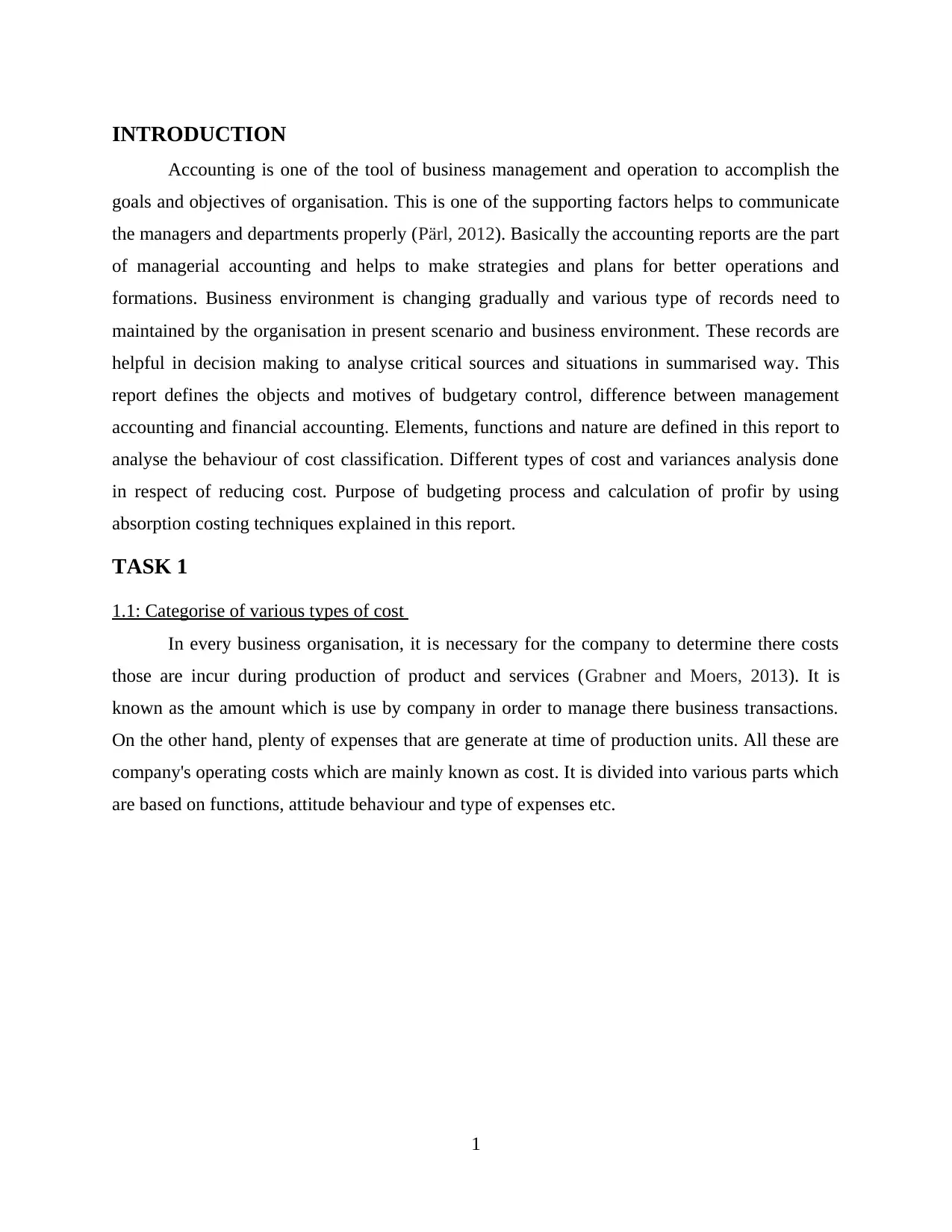
INTRODUCTION
Accounting is one of the tool of business management and operation to accomplish the
goals and objectives of organisation. This is one of the supporting factors helps to communicate
the managers and departments properly (Pärl, 2012). Basically the accounting reports are the part
of managerial accounting and helps to make strategies and plans for better operations and
formations. Business environment is changing gradually and various type of records need to
maintained by the organisation in present scenario and business environment. These records are
helpful in decision making to analyse critical sources and situations in summarised way. This
report defines the objects and motives of budgetary control, difference between management
accounting and financial accounting. Elements, functions and nature are defined in this report to
analyse the behaviour of cost classification. Different types of cost and variances analysis done
in respect of reducing cost. Purpose of budgeting process and calculation of profir by using
absorption costing techniques explained in this report.
TASK 1
1.1: Categorise of various types of cost
In every business organisation, it is necessary for the company to determine there costs
those are incur during production of product and services (Grabner and Moers, 2013). It is
known as the amount which is use by company in order to manage there business transactions.
On the other hand, plenty of expenses that are generate at time of production units. All these are
company's operating costs which are mainly known as cost. It is divided into various parts which
are based on functions, attitude behaviour and type of expenses etc.
1
Accounting is one of the tool of business management and operation to accomplish the
goals and objectives of organisation. This is one of the supporting factors helps to communicate
the managers and departments properly (Pärl, 2012). Basically the accounting reports are the part
of managerial accounting and helps to make strategies and plans for better operations and
formations. Business environment is changing gradually and various type of records need to
maintained by the organisation in present scenario and business environment. These records are
helpful in decision making to analyse critical sources and situations in summarised way. This
report defines the objects and motives of budgetary control, difference between management
accounting and financial accounting. Elements, functions and nature are defined in this report to
analyse the behaviour of cost classification. Different types of cost and variances analysis done
in respect of reducing cost. Purpose of budgeting process and calculation of profir by using
absorption costing techniques explained in this report.
TASK 1
1.1: Categorise of various types of cost
In every business organisation, it is necessary for the company to determine there costs
those are incur during production of product and services (Grabner and Moers, 2013). It is
known as the amount which is use by company in order to manage there business transactions.
On the other hand, plenty of expenses that are generate at time of production units. All these are
company's operating costs which are mainly known as cost. It is divided into various parts which
are based on functions, attitude behaviour and type of expenses etc.
1
⊘ This is a preview!⊘
Do you want full access?
Subscribe today to unlock all pages.

Trusted by 1+ million students worldwide
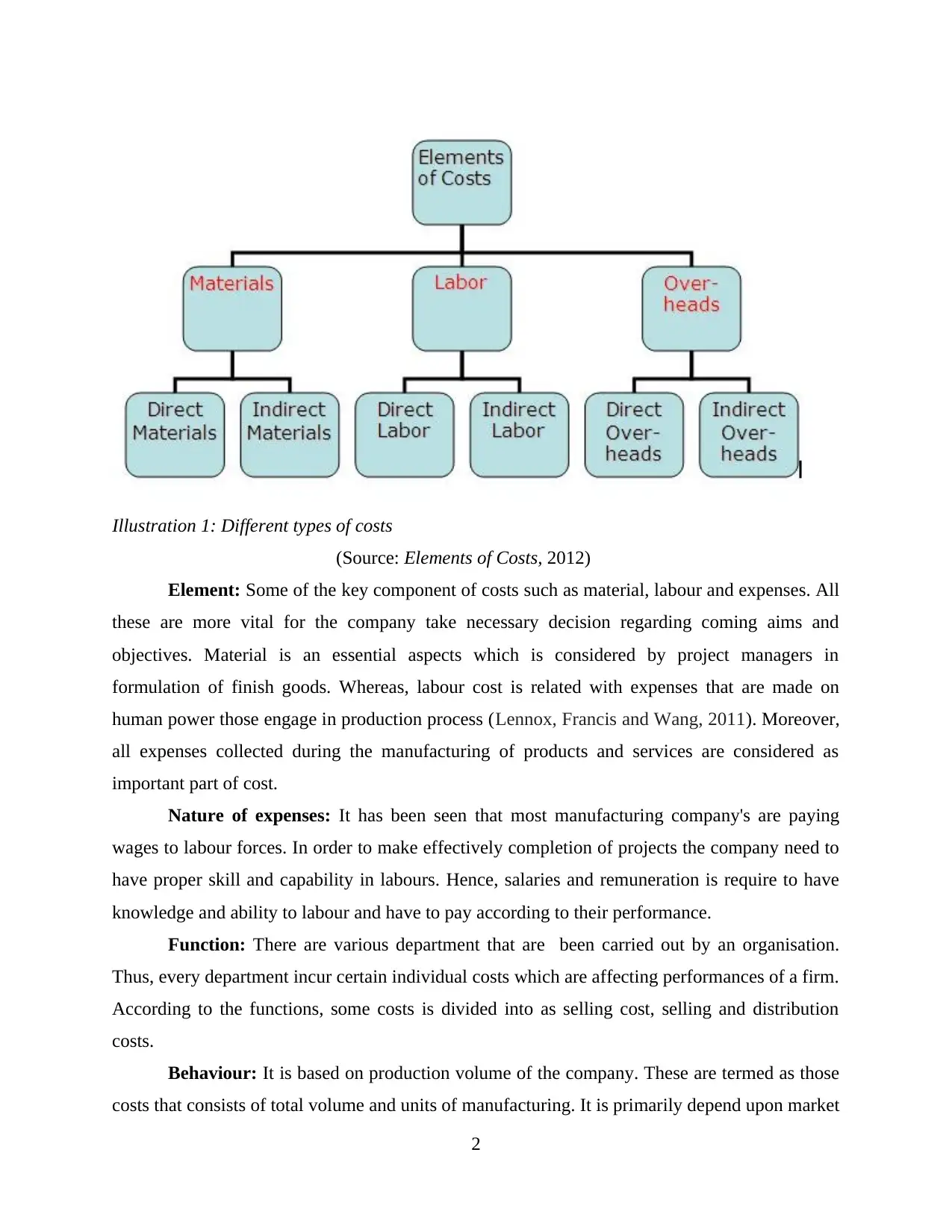
Illustration 1: Different types of costs
(Source: Elements of Costs, 2012)
Element: Some of the key component of costs such as material, labour and expenses. All
these are more vital for the company take necessary decision regarding coming aims and
objectives. Material is an essential aspects which is considered by project managers in
formulation of finish goods. Whereas, labour cost is related with expenses that are made on
human power those engage in production process (Lennox, Francis and Wang, 2011). Moreover,
all expenses collected during the manufacturing of products and services are considered as
important part of cost.
Nature of expenses: It has been seen that most manufacturing company's are paying
wages to labour forces. In order to make effectively completion of projects the company need to
have proper skill and capability in labours. Hence, salaries and remuneration is require to have
knowledge and ability to labour and have to pay according to their performance.
Function: There are various department that are been carried out by an organisation.
Thus, every department incur certain individual costs which are affecting performances of a firm.
According to the functions, some costs is divided into as selling cost, selling and distribution
costs.
Behaviour: It is based on production volume of the company. These are termed as those
costs that consists of total volume and units of manufacturing. It is primarily depend upon market
2
(Source: Elements of Costs, 2012)
Element: Some of the key component of costs such as material, labour and expenses. All
these are more vital for the company take necessary decision regarding coming aims and
objectives. Material is an essential aspects which is considered by project managers in
formulation of finish goods. Whereas, labour cost is related with expenses that are made on
human power those engage in production process (Lennox, Francis and Wang, 2011). Moreover,
all expenses collected during the manufacturing of products and services are considered as
important part of cost.
Nature of expenses: It has been seen that most manufacturing company's are paying
wages to labour forces. In order to make effectively completion of projects the company need to
have proper skill and capability in labours. Hence, salaries and remuneration is require to have
knowledge and ability to labour and have to pay according to their performance.
Function: There are various department that are been carried out by an organisation.
Thus, every department incur certain individual costs which are affecting performances of a firm.
According to the functions, some costs is divided into as selling cost, selling and distribution
costs.
Behaviour: It is based on production volume of the company. These are termed as those
costs that consists of total volume and units of manufacturing. It is primarily depend upon market
2
Paraphrase This Document
Need a fresh take? Get an instant paraphrase of this document with our AI Paraphraser
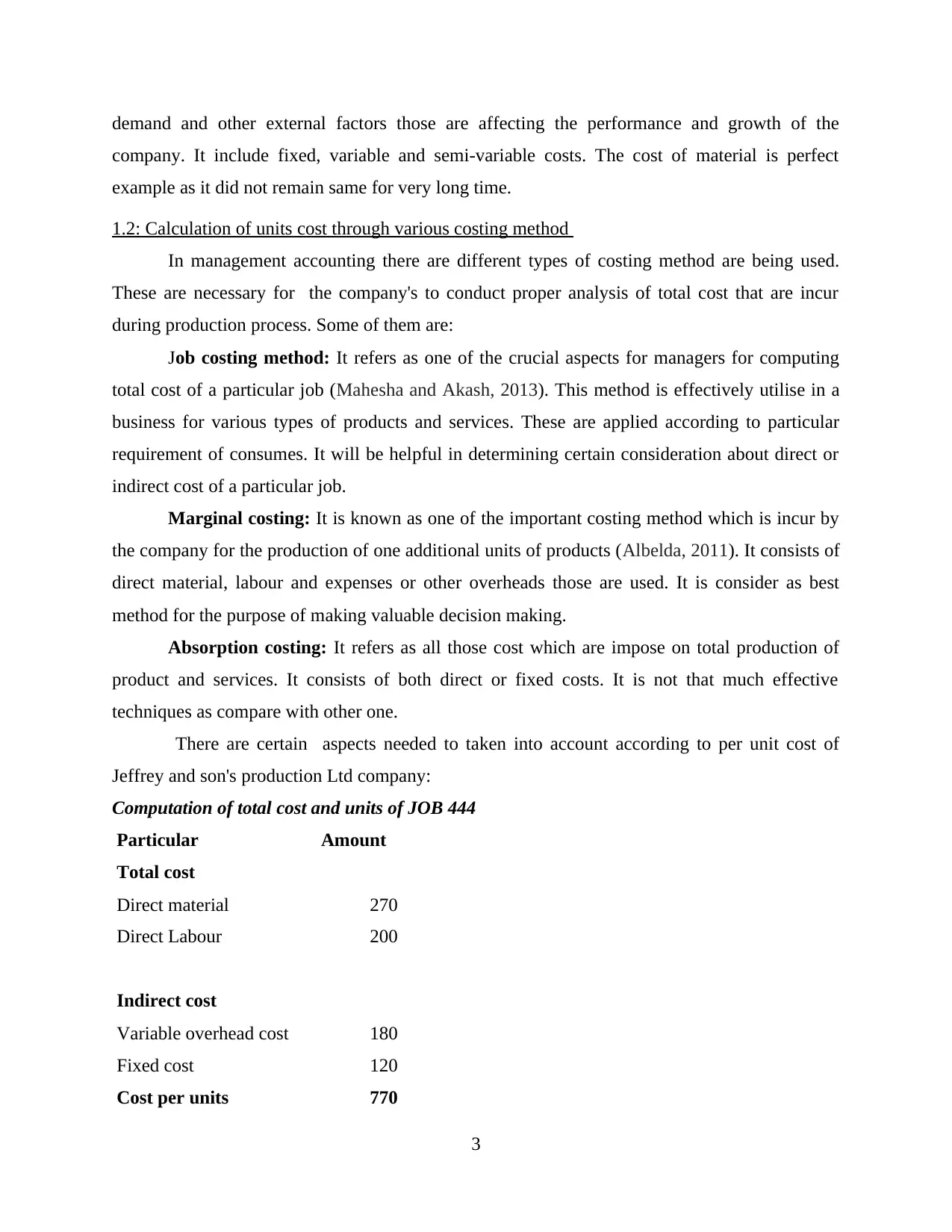
demand and other external factors those are affecting the performance and growth of the
company. It include fixed, variable and semi-variable costs. The cost of material is perfect
example as it did not remain same for very long time.
1.2: Calculation of units cost through various costing method
In management accounting there are different types of costing method are being used.
These are necessary for the company's to conduct proper analysis of total cost that are incur
during production process. Some of them are:
Job costing method: It refers as one of the crucial aspects for managers for computing
total cost of a particular job (Mahesha and Akash, 2013). This method is effectively utilise in a
business for various types of products and services. These are applied according to particular
requirement of consumes. It will be helpful in determining certain consideration about direct or
indirect cost of a particular job.
Marginal costing: It is known as one of the important costing method which is incur by
the company for the production of one additional units of products (Albelda, 2011). It consists of
direct material, labour and expenses or other overheads those are used. It is consider as best
method for the purpose of making valuable decision making.
Absorption costing: It refers as all those cost which are impose on total production of
product and services. It consists of both direct or fixed costs. It is not that much effective
techniques as compare with other one.
There are certain aspects needed to taken into account according to per unit cost of
Jeffrey and son's production Ltd company:
Computation of total cost and units of JOB 444
Particular Amount
Total cost
Direct material 270
Direct Labour 200
Indirect cost
Variable overhead cost 180
Fixed cost 120
Cost per units 770
3
company. It include fixed, variable and semi-variable costs. The cost of material is perfect
example as it did not remain same for very long time.
1.2: Calculation of units cost through various costing method
In management accounting there are different types of costing method are being used.
These are necessary for the company's to conduct proper analysis of total cost that are incur
during production process. Some of them are:
Job costing method: It refers as one of the crucial aspects for managers for computing
total cost of a particular job (Mahesha and Akash, 2013). This method is effectively utilise in a
business for various types of products and services. These are applied according to particular
requirement of consumes. It will be helpful in determining certain consideration about direct or
indirect cost of a particular job.
Marginal costing: It is known as one of the important costing method which is incur by
the company for the production of one additional units of products (Albelda, 2011). It consists of
direct material, labour and expenses or other overheads those are used. It is consider as best
method for the purpose of making valuable decision making.
Absorption costing: It refers as all those cost which are impose on total production of
product and services. It consists of both direct or fixed costs. It is not that much effective
techniques as compare with other one.
There are certain aspects needed to taken into account according to per unit cost of
Jeffrey and son's production Ltd company:
Computation of total cost and units of JOB 444
Particular Amount
Total cost
Direct material 270
Direct Labour 200
Indirect cost
Variable overhead cost 180
Fixed cost 120
Cost per units 770
3
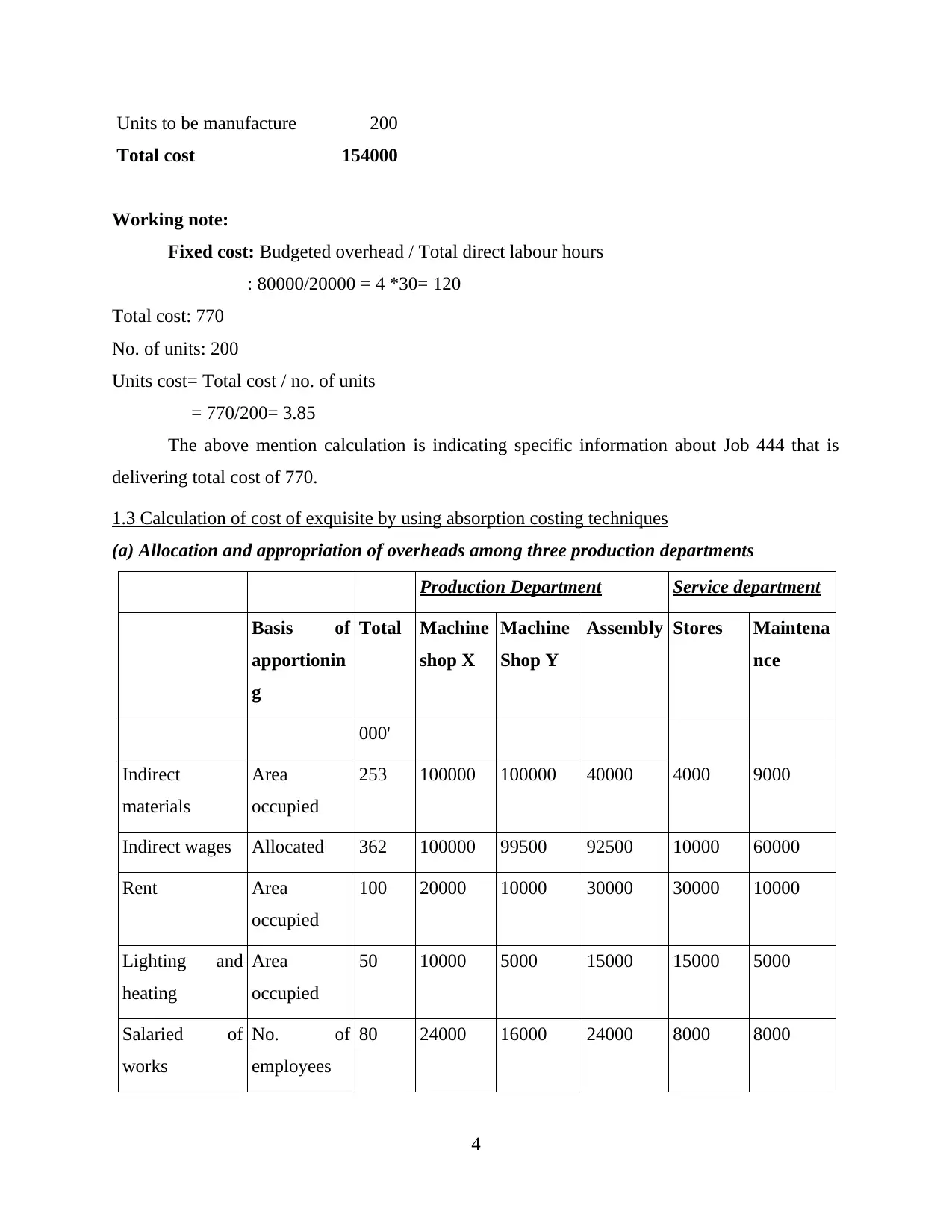
Units to be manufacture 200
Total cost 154000
Working note:
Fixed cost: Budgeted overhead / Total direct labour hours
: 80000/20000 = 4 *30= 120
Total cost: 770
No. of units: 200
Units cost= Total cost / no. of units
= 770/200= 3.85
The above mention calculation is indicating specific information about Job 444 that is
delivering total cost of 770.
1.3 Calculation of cost of exquisite by using absorption costing techniques
(a) Allocation and appropriation of overheads among three production departments
Production Department Service department
Basis of
apportionin
g
Total Machine
shop X
Machine
Shop Y
Assembly Stores Maintena
nce
000'
Indirect
materials
Area
occupied
253 100000 100000 40000 4000 9000
Indirect wages Allocated 362 100000 99500 92500 10000 60000
Rent Area
occupied
100 20000 10000 30000 30000 10000
Lighting and
heating
Area
occupied
50 10000 5000 15000 15000 5000
Salaried of
works
No. of
employees
80 24000 16000 24000 8000 8000
4
Total cost 154000
Working note:
Fixed cost: Budgeted overhead / Total direct labour hours
: 80000/20000 = 4 *30= 120
Total cost: 770
No. of units: 200
Units cost= Total cost / no. of units
= 770/200= 3.85
The above mention calculation is indicating specific information about Job 444 that is
delivering total cost of 770.
1.3 Calculation of cost of exquisite by using absorption costing techniques
(a) Allocation and appropriation of overheads among three production departments
Production Department Service department
Basis of
apportionin
g
Total Machine
shop X
Machine
Shop Y
Assembly Stores Maintena
nce
000'
Indirect
materials
Area
occupied
253 100000 100000 40000 4000 9000
Indirect wages Allocated 362 100000 99500 92500 10000 60000
Rent Area
occupied
100 20000 10000 30000 30000 10000
Lighting and
heating
Area
occupied
50 10000 5000 15000 15000 5000
Salaried of
works
No. of
employees
80 24000 16000 24000 8000 8000
4
⊘ This is a preview!⊘
Do you want full access?
Subscribe today to unlock all pages.

Trusted by 1+ million students worldwide
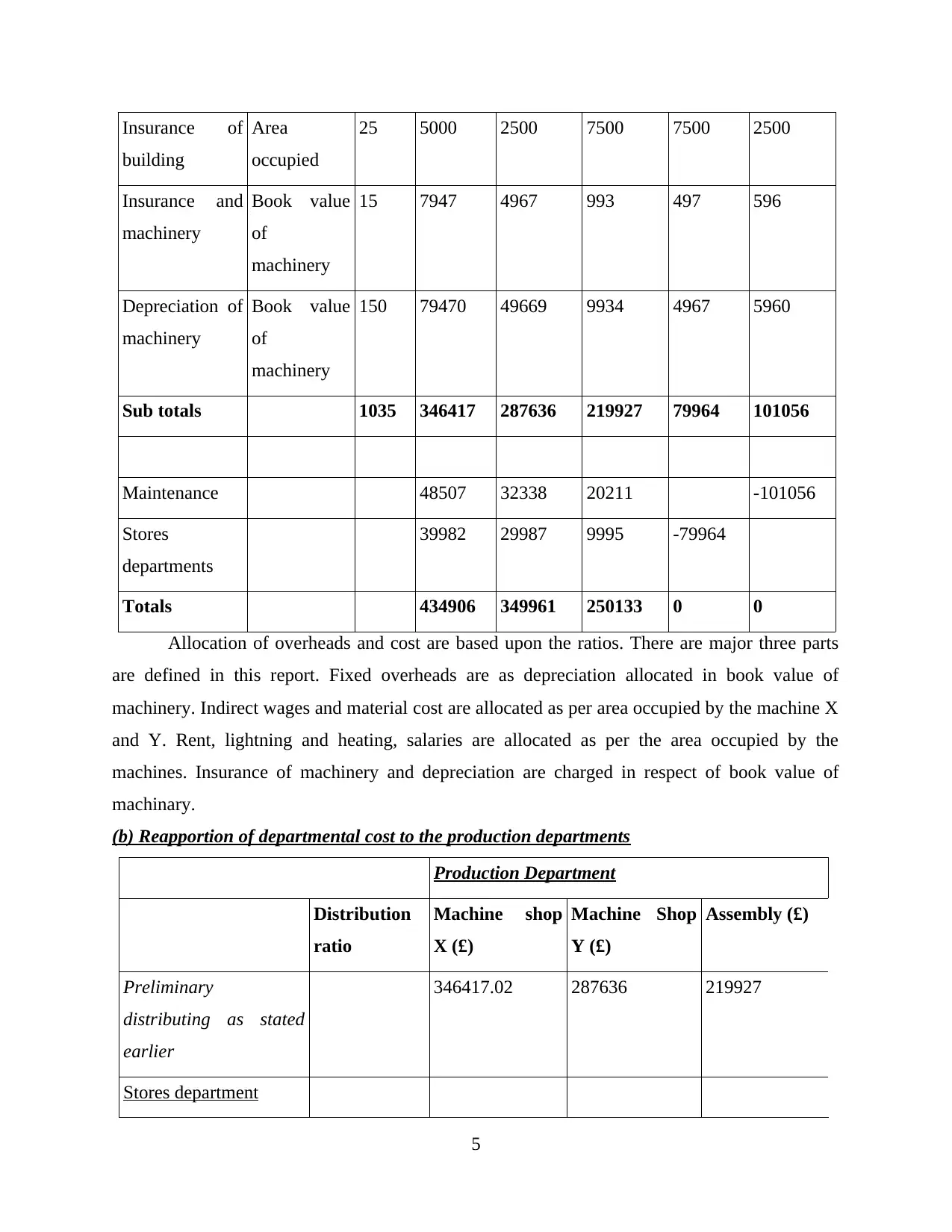
Insurance of
building
Area
occupied
25 5000 2500 7500 7500 2500
Insurance and
machinery
Book value
of
machinery
15 7947 4967 993 497 596
Depreciation of
machinery
Book value
of
machinery
150 79470 49669 9934 4967 5960
Sub totals 1035 346417 287636 219927 79964 101056
Maintenance 48507 32338 20211 -101056
Stores
departments
39982 29987 9995 -79964
Totals 434906 349961 250133 0 0
Allocation of overheads and cost are based upon the ratios. There are major three parts
are defined in this report. Fixed overheads are as depreciation allocated in book value of
machinery. Indirect wages and material cost are allocated as per area occupied by the machine X
and Y. Rent, lightning and heating, salaries are allocated as per the area occupied by the
machines. Insurance of machinery and depreciation are charged in respect of book value of
machinary.
(b) Reapportion of departmental cost to the production departments
Production Department
Distribution
ratio
Machine shop
X (£)
Machine Shop
Y (£)
Assembly (£)
Preliminary
distributing as stated
earlier
346417.02 287636 219927
Stores department
5
building
Area
occupied
25 5000 2500 7500 7500 2500
Insurance and
machinery
Book value
of
machinery
15 7947 4967 993 497 596
Depreciation of
machinery
Book value
of
machinery
150 79470 49669 9934 4967 5960
Sub totals 1035 346417 287636 219927 79964 101056
Maintenance 48507 32338 20211 -101056
Stores
departments
39982 29987 9995 -79964
Totals 434906 349961 250133 0 0
Allocation of overheads and cost are based upon the ratios. There are major three parts
are defined in this report. Fixed overheads are as depreciation allocated in book value of
machinery. Indirect wages and material cost are allocated as per area occupied by the machine X
and Y. Rent, lightning and heating, salaries are allocated as per the area occupied by the
machines. Insurance of machinery and depreciation are charged in respect of book value of
machinary.
(b) Reapportion of departmental cost to the production departments
Production Department
Distribution
ratio
Machine shop
X (£)
Machine Shop
Y (£)
Assembly (£)
Preliminary
distributing as stated
earlier
346417.02 287636 219927
Stores department
5
Paraphrase This Document
Need a fresh take? Get an instant paraphrase of this document with our AI Paraphraser
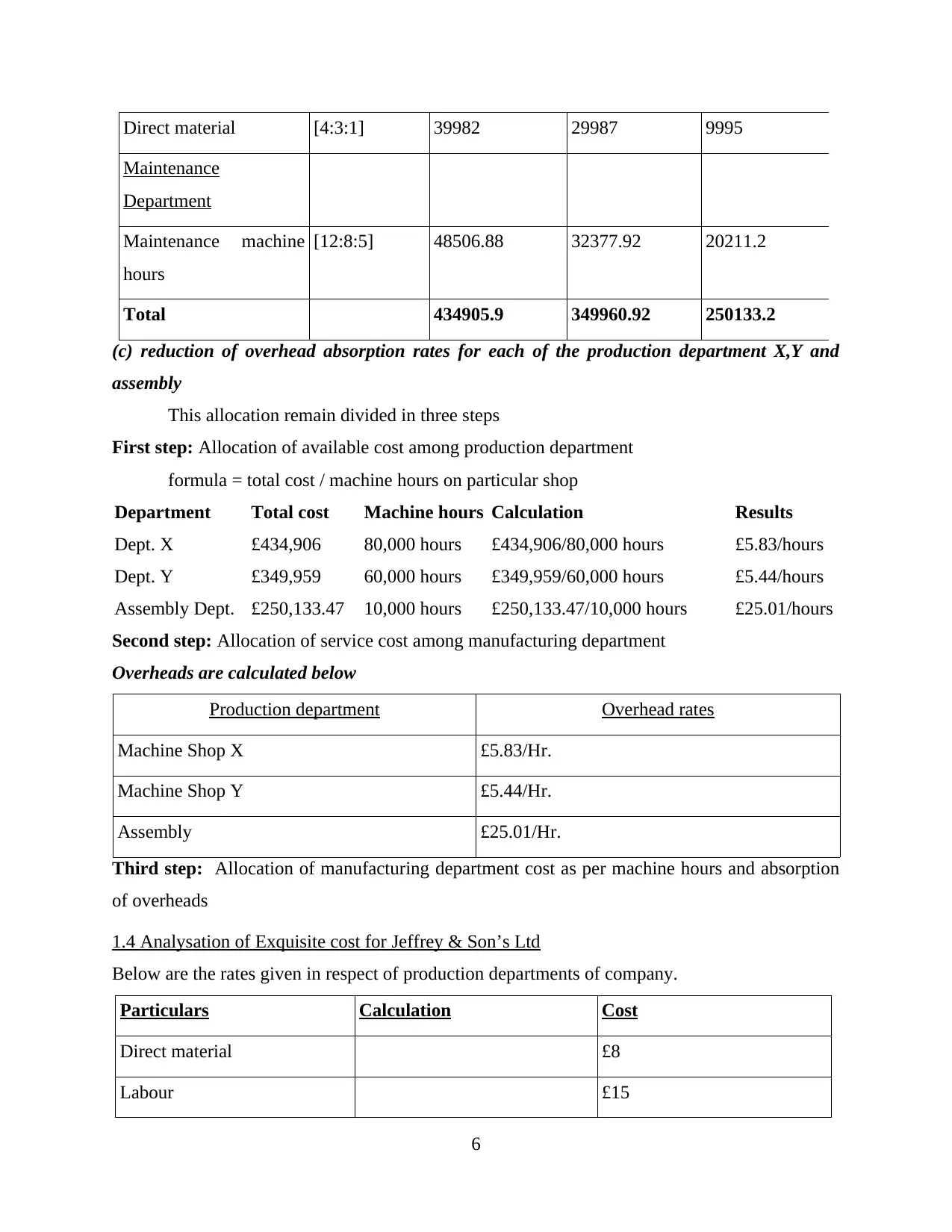
Direct material [4:3:1] 39982 29987 9995
Maintenance
Department
Maintenance machine
hours
[12:8:5] 48506.88 32377.92 20211.2
Total 434905.9 349960.92 250133.2
(c) reduction of overhead absorption rates for each of the production department X,Y and
assembly
This allocation remain divided in three steps
First step: Allocation of available cost among production department
formula = total cost / machine hours on particular shop
Department Total cost Machine hours Calculation Results
Dept. X £434,906 80,000 hours £434,906/80,000 hours £5.83/hours
Dept. Y £349,959 60,000 hours £349,959/60,000 hours £5.44/hours
Assembly Dept. £250,133.47 10,000 hours £250,133.47/10,000 hours £25.01/hours
Second step: Allocation of service cost among manufacturing department
Overheads are calculated below
Production department Overhead rates
Machine Shop X £5.83/Hr.
Machine Shop Y £5.44/Hr.
Assembly £25.01/Hr.
Third step: Allocation of manufacturing department cost as per machine hours and absorption
of overheads
1.4 Analysation of Exquisite cost for Jeffrey & Son’s Ltd
Below are the rates given in respect of production departments of company.
Particulars Calculation Cost
Direct material £8
Labour £15
6
Maintenance
Department
Maintenance machine
hours
[12:8:5] 48506.88 32377.92 20211.2
Total 434905.9 349960.92 250133.2
(c) reduction of overhead absorption rates for each of the production department X,Y and
assembly
This allocation remain divided in three steps
First step: Allocation of available cost among production department
formula = total cost / machine hours on particular shop
Department Total cost Machine hours Calculation Results
Dept. X £434,906 80,000 hours £434,906/80,000 hours £5.83/hours
Dept. Y £349,959 60,000 hours £349,959/60,000 hours £5.44/hours
Assembly Dept. £250,133.47 10,000 hours £250,133.47/10,000 hours £25.01/hours
Second step: Allocation of service cost among manufacturing department
Overheads are calculated below
Production department Overhead rates
Machine Shop X £5.83/Hr.
Machine Shop Y £5.44/Hr.
Assembly £25.01/Hr.
Third step: Allocation of manufacturing department cost as per machine hours and absorption
of overheads
1.4 Analysation of Exquisite cost for Jeffrey & Son’s Ltd
Below are the rates given in respect of production departments of company.
Particulars Calculation Cost
Direct material £8
Labour £15
6
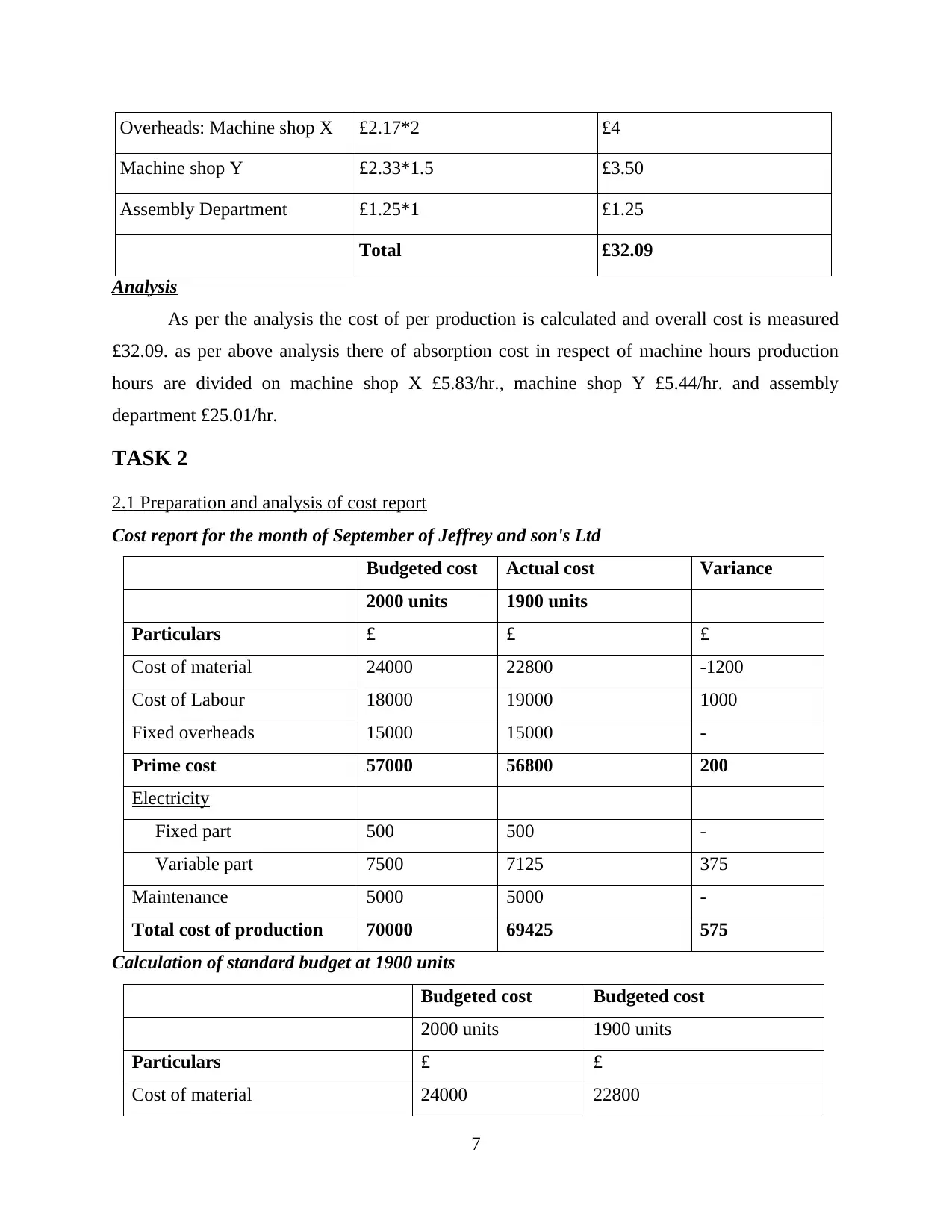
Overheads: Machine shop X £2.17*2 £4
Machine shop Y £2.33*1.5 £3.50
Assembly Department £1.25*1 £1.25
Total £32.09
Analysis
As per the analysis the cost of per production is calculated and overall cost is measured
£32.09. as per above analysis there of absorption cost in respect of machine hours production
hours are divided on machine shop X £5.83/hr., machine shop Y £5.44/hr. and assembly
department £25.01/hr.
TASK 2
2.1 Preparation and analysis of cost report
Cost report for the month of September of Jeffrey and son's Ltd
Budgeted cost Actual cost Variance
2000 units 1900 units
Particulars £ £ £
Cost of material 24000 22800 -1200
Cost of Labour 18000 19000 1000
Fixed overheads 15000 15000 -
Prime cost 57000 56800 200
Electricity
Fixed part 500 500 -
Variable part 7500 7125 375
Maintenance 5000 5000 -
Total cost of production 70000 69425 575
Calculation of standard budget at 1900 units
Budgeted cost Budgeted cost
2000 units 1900 units
Particulars £ £
Cost of material 24000 22800
7
Machine shop Y £2.33*1.5 £3.50
Assembly Department £1.25*1 £1.25
Total £32.09
Analysis
As per the analysis the cost of per production is calculated and overall cost is measured
£32.09. as per above analysis there of absorption cost in respect of machine hours production
hours are divided on machine shop X £5.83/hr., machine shop Y £5.44/hr. and assembly
department £25.01/hr.
TASK 2
2.1 Preparation and analysis of cost report
Cost report for the month of September of Jeffrey and son's Ltd
Budgeted cost Actual cost Variance
2000 units 1900 units
Particulars £ £ £
Cost of material 24000 22800 -1200
Cost of Labour 18000 19000 1000
Fixed overheads 15000 15000 -
Prime cost 57000 56800 200
Electricity
Fixed part 500 500 -
Variable part 7500 7125 375
Maintenance 5000 5000 -
Total cost of production 70000 69425 575
Calculation of standard budget at 1900 units
Budgeted cost Budgeted cost
2000 units 1900 units
Particulars £ £
Cost of material 24000 22800
7
⊘ This is a preview!⊘
Do you want full access?
Subscribe today to unlock all pages.

Trusted by 1+ million students worldwide
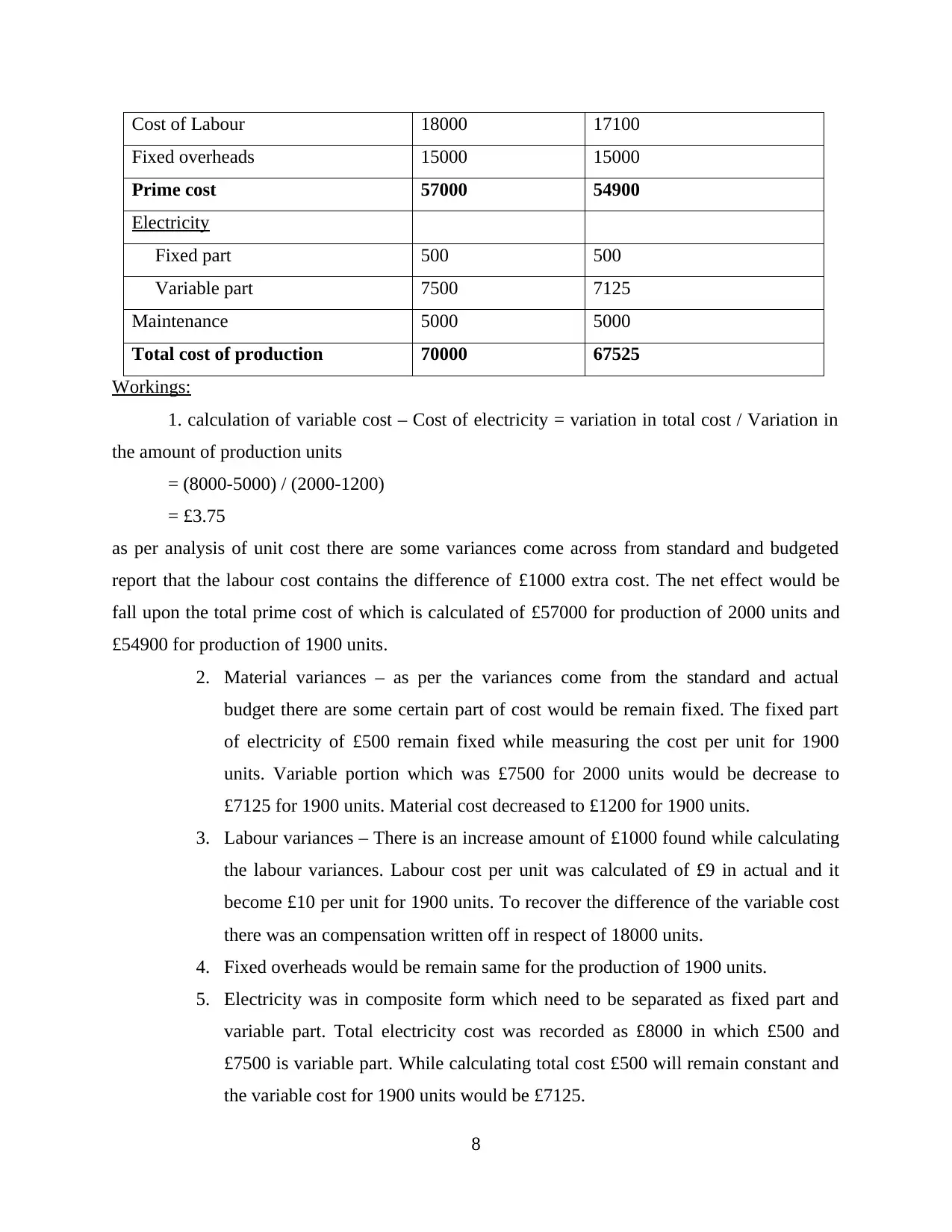
Cost of Labour 18000 17100
Fixed overheads 15000 15000
Prime cost 57000 54900
Electricity
Fixed part 500 500
Variable part 7500 7125
Maintenance 5000 5000
Total cost of production 70000 67525
Workings:
1. calculation of variable cost – Cost of electricity = variation in total cost / Variation in
the amount of production units
= (8000-5000) / (2000-1200)
= £3.75
as per analysis of unit cost there are some variances come across from standard and budgeted
report that the labour cost contains the difference of £1000 extra cost. The net effect would be
fall upon the total prime cost of which is calculated of £57000 for production of 2000 units and
£54900 for production of 1900 units.
2. Material variances – as per the variances come from the standard and actual
budget there are some certain part of cost would be remain fixed. The fixed part
of electricity of £500 remain fixed while measuring the cost per unit for 1900
units. Variable portion which was £7500 for 2000 units would be decrease to
£7125 for 1900 units. Material cost decreased to £1200 for 1900 units.
3. Labour variances – There is an increase amount of £1000 found while calculating
the labour variances. Labour cost per unit was calculated of £9 in actual and it
become £10 per unit for 1900 units. To recover the difference of the variable cost
there was an compensation written off in respect of 18000 units.
4. Fixed overheads would be remain same for the production of 1900 units.
5. Electricity was in composite form which need to be separated as fixed part and
variable part. Total electricity cost was recorded as £8000 in which £500 and
£7500 is variable part. While calculating total cost £500 will remain constant and
the variable cost for 1900 units would be £7125.
8
Fixed overheads 15000 15000
Prime cost 57000 54900
Electricity
Fixed part 500 500
Variable part 7500 7125
Maintenance 5000 5000
Total cost of production 70000 67525
Workings:
1. calculation of variable cost – Cost of electricity = variation in total cost / Variation in
the amount of production units
= (8000-5000) / (2000-1200)
= £3.75
as per analysis of unit cost there are some variances come across from standard and budgeted
report that the labour cost contains the difference of £1000 extra cost. The net effect would be
fall upon the total prime cost of which is calculated of £57000 for production of 2000 units and
£54900 for production of 1900 units.
2. Material variances – as per the variances come from the standard and actual
budget there are some certain part of cost would be remain fixed. The fixed part
of electricity of £500 remain fixed while measuring the cost per unit for 1900
units. Variable portion which was £7500 for 2000 units would be decrease to
£7125 for 1900 units. Material cost decreased to £1200 for 1900 units.
3. Labour variances – There is an increase amount of £1000 found while calculating
the labour variances. Labour cost per unit was calculated of £9 in actual and it
become £10 per unit for 1900 units. To recover the difference of the variable cost
there was an compensation written off in respect of 18000 units.
4. Fixed overheads would be remain same for the production of 1900 units.
5. Electricity was in composite form which need to be separated as fixed part and
variable part. Total electricity cost was recorded as £8000 in which £500 and
£7500 is variable part. While calculating total cost £500 will remain constant and
the variable cost for 1900 units would be £7125.
8
Paraphrase This Document
Need a fresh take? Get an instant paraphrase of this document with our AI Paraphraser
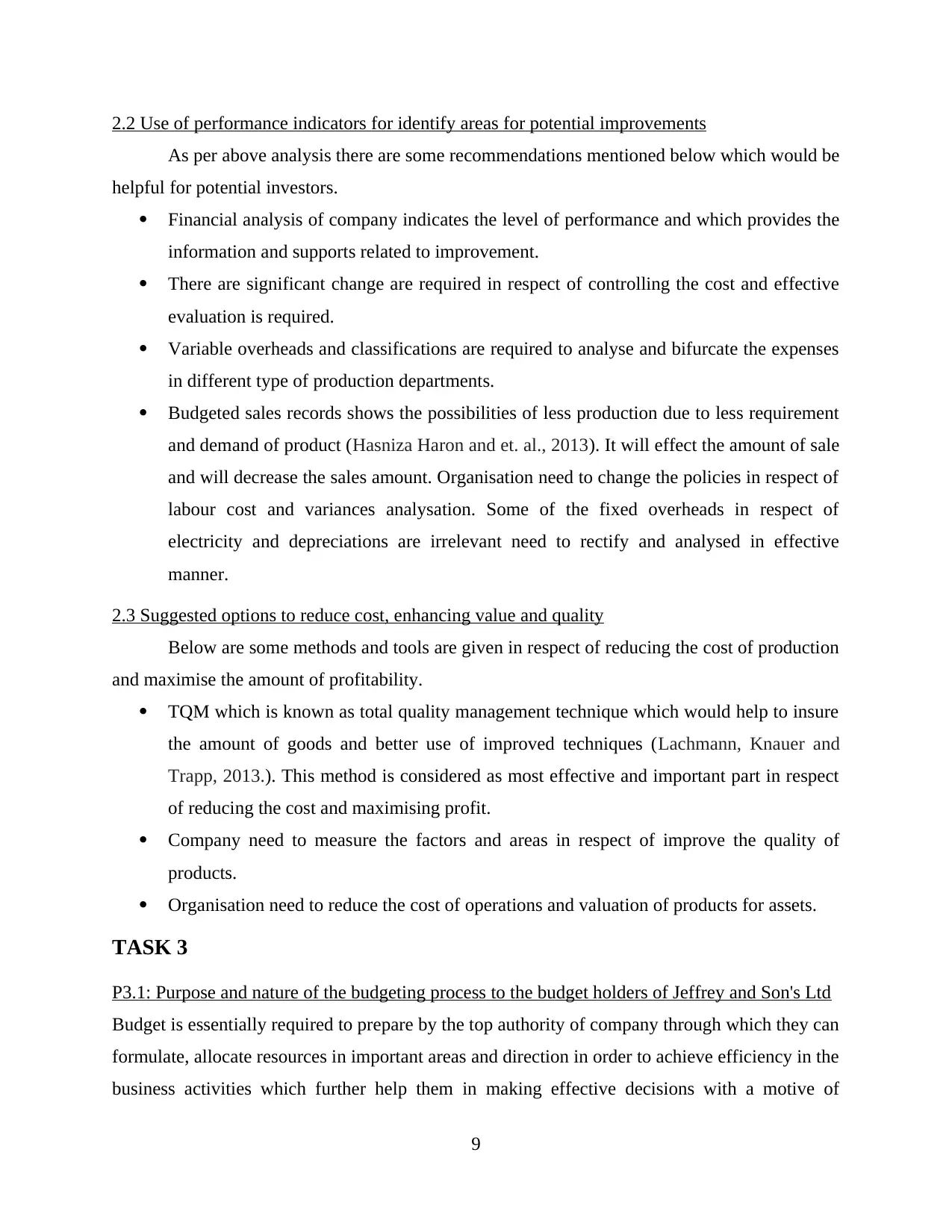
2.2 Use of performance indicators for identify areas for potential improvements
As per above analysis there are some recommendations mentioned below which would be
helpful for potential investors.
Financial analysis of company indicates the level of performance and which provides the
information and supports related to improvement.
There are significant change are required in respect of controlling the cost and effective
evaluation is required.
Variable overheads and classifications are required to analyse and bifurcate the expenses
in different type of production departments.
Budgeted sales records shows the possibilities of less production due to less requirement
and demand of product (Hasniza Haron and et. al., 2013). It will effect the amount of sale
and will decrease the sales amount. Organisation need to change the policies in respect of
labour cost and variances analysation. Some of the fixed overheads in respect of
electricity and depreciations are irrelevant need to rectify and analysed in effective
manner.
2.3 Suggested options to reduce cost, enhancing value and quality
Below are some methods and tools are given in respect of reducing the cost of production
and maximise the amount of profitability.
TQM which is known as total quality management technique which would help to insure
the amount of goods and better use of improved techniques (Lachmann, Knauer and
Trapp, 2013.). This method is considered as most effective and important part in respect
of reducing the cost and maximising profit.
Company need to measure the factors and areas in respect of improve the quality of
products.
Organisation need to reduce the cost of operations and valuation of products for assets.
TASK 3
P3.1: Purpose and nature of the budgeting process to the budget holders of Jeffrey and Son's Ltd
Budget is essentially required to prepare by the top authority of company through which they can
formulate, allocate resources in important areas and direction in order to achieve efficiency in the
business activities which further help them in making effective decisions with a motive of
9
As per above analysis there are some recommendations mentioned below which would be
helpful for potential investors.
Financial analysis of company indicates the level of performance and which provides the
information and supports related to improvement.
There are significant change are required in respect of controlling the cost and effective
evaluation is required.
Variable overheads and classifications are required to analyse and bifurcate the expenses
in different type of production departments.
Budgeted sales records shows the possibilities of less production due to less requirement
and demand of product (Hasniza Haron and et. al., 2013). It will effect the amount of sale
and will decrease the sales amount. Organisation need to change the policies in respect of
labour cost and variances analysation. Some of the fixed overheads in respect of
electricity and depreciations are irrelevant need to rectify and analysed in effective
manner.
2.3 Suggested options to reduce cost, enhancing value and quality
Below are some methods and tools are given in respect of reducing the cost of production
and maximise the amount of profitability.
TQM which is known as total quality management technique which would help to insure
the amount of goods and better use of improved techniques (Lachmann, Knauer and
Trapp, 2013.). This method is considered as most effective and important part in respect
of reducing the cost and maximising profit.
Company need to measure the factors and areas in respect of improve the quality of
products.
Organisation need to reduce the cost of operations and valuation of products for assets.
TASK 3
P3.1: Purpose and nature of the budgeting process to the budget holders of Jeffrey and Son's Ltd
Budget is essentially required to prepare by the top authority of company through which they can
formulate, allocate resources in important areas and direction in order to achieve efficiency in the
business activities which further help them in making effective decisions with a motive of
9
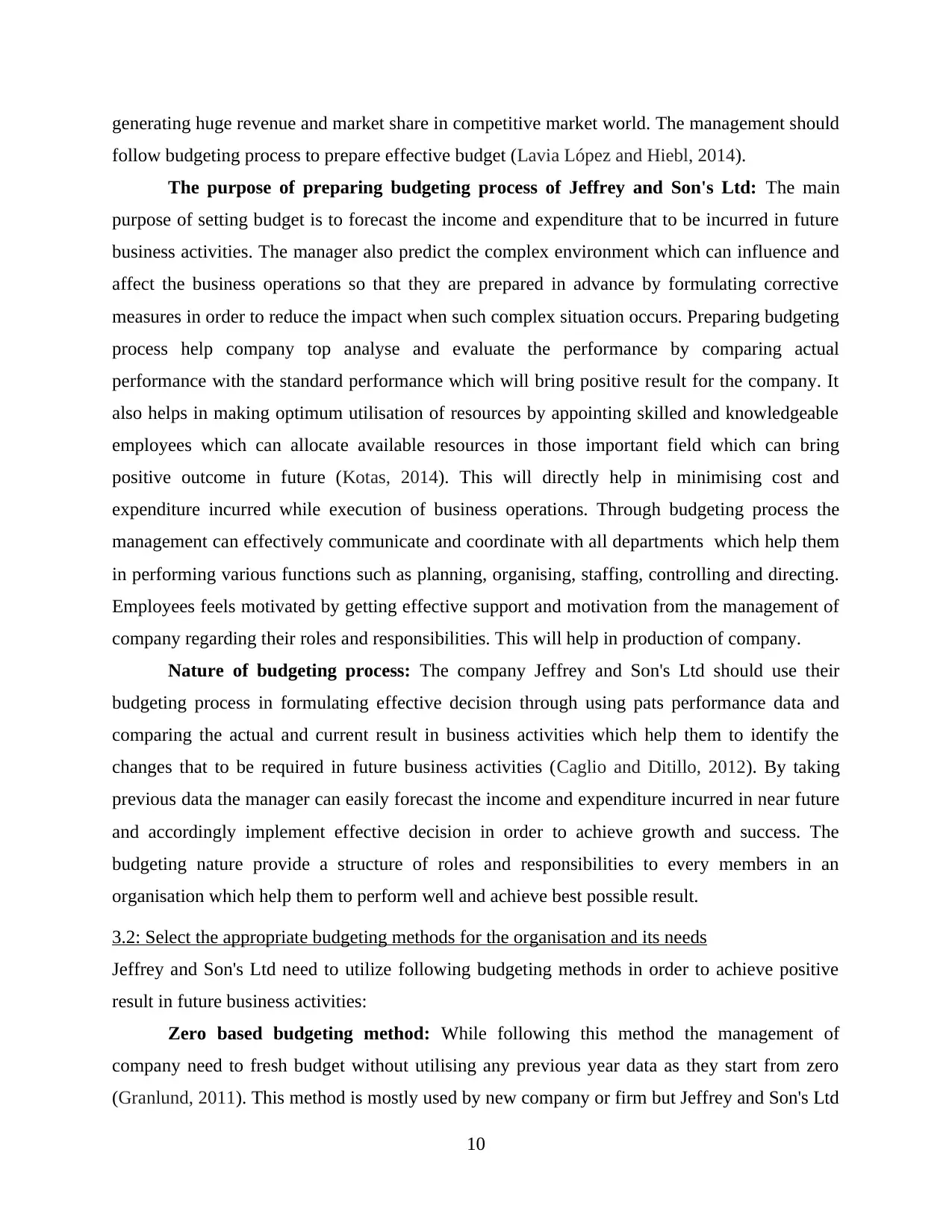
generating huge revenue and market share in competitive market world. The management should
follow budgeting process to prepare effective budget (Lavia López and Hiebl, 2014).
The purpose of preparing budgeting process of Jeffrey and Son's Ltd: The main
purpose of setting budget is to forecast the income and expenditure that to be incurred in future
business activities. The manager also predict the complex environment which can influence and
affect the business operations so that they are prepared in advance by formulating corrective
measures in order to reduce the impact when such complex situation occurs. Preparing budgeting
process help company top analyse and evaluate the performance by comparing actual
performance with the standard performance which will bring positive result for the company. It
also helps in making optimum utilisation of resources by appointing skilled and knowledgeable
employees which can allocate available resources in those important field which can bring
positive outcome in future (Kotas, 2014). This will directly help in minimising cost and
expenditure incurred while execution of business operations. Through budgeting process the
management can effectively communicate and coordinate with all departments which help them
in performing various functions such as planning, organising, staffing, controlling and directing.
Employees feels motivated by getting effective support and motivation from the management of
company regarding their roles and responsibilities. This will help in production of company.
Nature of budgeting process: The company Jeffrey and Son's Ltd should use their
budgeting process in formulating effective decision through using pats performance data and
comparing the actual and current result in business activities which help them to identify the
changes that to be required in future business activities (Caglio and Ditillo, 2012). By taking
previous data the manager can easily forecast the income and expenditure incurred in near future
and accordingly implement effective decision in order to achieve growth and success. The
budgeting nature provide a structure of roles and responsibilities to every members in an
organisation which help them to perform well and achieve best possible result.
3.2: Select the appropriate budgeting methods for the organisation and its needs
Jeffrey and Son's Ltd need to utilize following budgeting methods in order to achieve positive
result in future business activities:
Zero based budgeting method: While following this method the management of
company need to fresh budget without utilising any previous year data as they start from zero
(Granlund, 2011). This method is mostly used by new company or firm but Jeffrey and Son's Ltd
10
follow budgeting process to prepare effective budget (Lavia López and Hiebl, 2014).
The purpose of preparing budgeting process of Jeffrey and Son's Ltd: The main
purpose of setting budget is to forecast the income and expenditure that to be incurred in future
business activities. The manager also predict the complex environment which can influence and
affect the business operations so that they are prepared in advance by formulating corrective
measures in order to reduce the impact when such complex situation occurs. Preparing budgeting
process help company top analyse and evaluate the performance by comparing actual
performance with the standard performance which will bring positive result for the company. It
also helps in making optimum utilisation of resources by appointing skilled and knowledgeable
employees which can allocate available resources in those important field which can bring
positive outcome in future (Kotas, 2014). This will directly help in minimising cost and
expenditure incurred while execution of business operations. Through budgeting process the
management can effectively communicate and coordinate with all departments which help them
in performing various functions such as planning, organising, staffing, controlling and directing.
Employees feels motivated by getting effective support and motivation from the management of
company regarding their roles and responsibilities. This will help in production of company.
Nature of budgeting process: The company Jeffrey and Son's Ltd should use their
budgeting process in formulating effective decision through using pats performance data and
comparing the actual and current result in business activities which help them to identify the
changes that to be required in future business activities (Caglio and Ditillo, 2012). By taking
previous data the manager can easily forecast the income and expenditure incurred in near future
and accordingly implement effective decision in order to achieve growth and success. The
budgeting nature provide a structure of roles and responsibilities to every members in an
organisation which help them to perform well and achieve best possible result.
3.2: Select the appropriate budgeting methods for the organisation and its needs
Jeffrey and Son's Ltd need to utilize following budgeting methods in order to achieve positive
result in future business activities:
Zero based budgeting method: While following this method the management of
company need to fresh budget without utilising any previous year data as they start from zero
(Granlund, 2011). This method is mostly used by new company or firm but Jeffrey and Son's Ltd
10
⊘ This is a preview!⊘
Do you want full access?
Subscribe today to unlock all pages.

Trusted by 1+ million students worldwide
1 out of 20
Related Documents
Your All-in-One AI-Powered Toolkit for Academic Success.
+13062052269
info@desklib.com
Available 24*7 on WhatsApp / Email
![[object Object]](/_next/static/media/star-bottom.7253800d.svg)
Unlock your academic potential
Copyright © 2020–2025 A2Z Services. All Rights Reserved. Developed and managed by ZUCOL.





